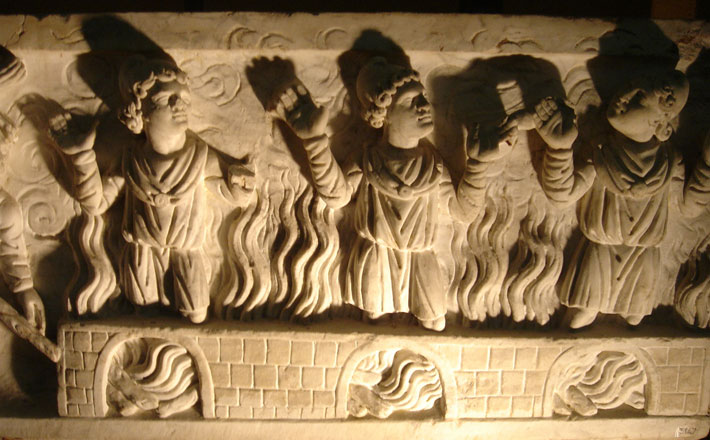Commentary on Isaiah 55:1-11
Any preacher whose congregation will be celebrating the Vigil of Easter will encounter this text when the assembly listens to Old Testament (OT) readings.
This is one of at least four — and as many as twelve — of the most significant faith stories from our Hebrew ancestors that through the centuries have been chosen for the Vigil readings. Isaiah 55:1-11 includes both invitation (“Ho, everyone who thirsts, come to the waters and you that have no money, come, buy and eat!”) and the promise of forgiveness (“my thoughts are not your thoughts … ”).
Although a preacher may be overwhelmed by the wealth of texts on this night, do not be dismayed. The Resurrection is the subject of preaching on this night with equal emphasis on the baptismal calling of the body of Christ. Let the OT texts set the context for these matters. Assuming all twelve readings are heard, the trajectory of faith experiences and pronouncements adds layer upon layer of stories and imagery to the final proclamation.
Beginning with the Genesis account of creation, the assembly hears of the flood, the testing of Abraham, and escape through the waters to freedom. Isaiah 55:1-11 is next with its invitation to “the waters” and to a feast. The prophet’s cry is followed by a reading on God’s wisdom, two readings from Ezekiel (including the valley of the dry bones), gathering the people, Jonah coughed up by the fish, the people being clothed in garments of salvation, and deliverance from the fiery furnace. After each reading there may be silence or a song or other response to what is read and then a prayer. These texts constitute a wildly rich experience, usually bathed in candlelight as the night deepens.
The OT readings lead to Romans 6:3-11 (“all of us who have been baptized into Christ Jesus were baptized into his death … ”) and then John 20:1-18 in which Mary Magdalene, Jesus’ mother, and Salome go to the tomb and encounter the youth in white who says Jesus has gone ahead to Galilee.
The preaching of the Resurrection and resurrected life for all is informed and bolstered by the twelve readings, and this Isaiah text is a fine participant. A mysterious speaker coaxes the people, cries out in the street like a vendor of goods, enacting precisely what the Gospel reading also does — calling everyone to be refreshed. The image of the waters is set out as already available for knowing the ways of the Lord: “Come to the waters!” The speaker enacts what the sacramental baptismal washing and the meal of bread and wine say to us: Beloved, I have made you for feasting and abundant life. Come!
The invitation to free water and free food contrasts with the life known in exile with no assurance even of survival, let alone a feast. Isaiah 55 lays out the irony between what is costly and what is free. Under oppression, in exile, away from what is nourishing and familiar at home, the people live a truly expensive life. Although in democratic countries we often speak of the high cost of liberty, the price of exile is also great. The people pay with devastation, anguish, loneliness, guilt, shame, terror, and more. Who in your community, state, nation, and on earth live in conditions of exile, devoid of what is stable and nourishing? Where is anguish and hopelessness? Who are those who need to be invited to what is life-giving?
The question for the preacher in our time is this: What is the meaning of exile in our communities? Isaiah speaks to a community that is about to be liberated to return home. In order to make a gospel life as vivid as possible when proclaiming the Resurrection, it is necessary to bring to the assembly’s attention the reality of lives lived in need of freedom.
When you settle on who would find the invitation in Isaiah 55 incredible and unanswerable, you will know who (people, creatures) and what (landscapes, air, water) needs to be heard from on this day as the preacher strives to make real the meaning of the empty tomb. Think not only of individuals who are desperate. Think of whole communities fraught with turmoil over injustices, racial strife, disabilities, destruction, thwarted dreams. Think of the ways in which communities are afflicted with the life-destroying temptations and afflictions of wealth and power, whether or not they wield either of them.
Think, as well, of those who lead the way toward liberation. These are they who put the lie to values that do not satisfy, to dreams that turn to dust when achieved, and to hopes that are too shallow to serve as food. The liberators are Resurrection majorettes, if you will. In word and deed they give the rest of us energy. They fill our imaginations with visions of a better world for all. Who are they in your sphere? I dare say that most of us yearn to follow the thumping baton of someone who sees an enduring vision, whose words renew spirits. We all need those who in and out of the church lead us toward what makes for the common good. These people exist today. Most of us know at least one of them. Name them! Show us where to look for the goodness of God alive in the world.
The preacher declares on this night the promise of the risen one having gone ahead of us, opening us into the way of God, clear as rain and snow that waters the earth. We are all led by the one who knows the agony of exile, who died out of favor with both religious and political power structures, and who watched all of his friends turn away. If there is any exile greater, I do not know it. If there is any homecoming richer and more powerful than coming back forever to be with your friends and betrayers, I do not know that one, either. Preach that homecoming.


April 4, 2015